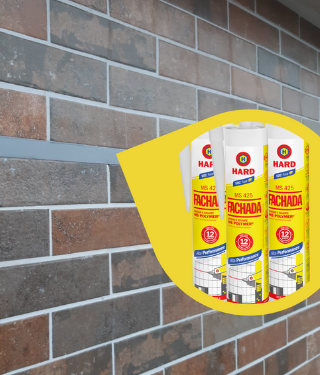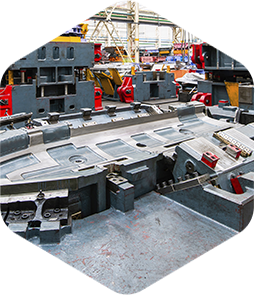Choosing the sealant for the facade of your venture is essential to ensure the safety and durability of the entire structure. For this reason, when you’re deciding, it is important to pay attention to some criteria, in order to avoid clenches, cracks, fissures and infiltrations.
There are numerous types of sealants for construction on the market, as we have shown in this article. That’s why choosing between so many options can be so complicated. So, what characteristics must the product have to ensure the sealing and protection of the facade?
If you’ve ever asked yourself this question, keep reading! We have gathered in this article 4 criteria to consider when choosing a facade sealant.
What is the importance of choosing the sealant for facade?
As already mentioned, using the right sealant on your facade can prevent problems that compromise the structure as a whole. This is because the sealant acts as a barrier against the unwanted passage of moisture, dust and other types of dirt. By doing it, it’s possible to prevent the emergence of infiltrations and other pathologies.
It is also among the main functions of this material to accommodate the dimensional variations of buildings, which is important to avoid clenches, cracks and fissures. Once the facades are made of materials with different expansion coefficients, which move according to the external temperature.
However, it is not enough just to use any sealant, it is important to choose a material suitable for the application environment. In case of facades, exposure to sunlight is very high and this has a great impact on the durability of the fence. This is just one example of how important it is to use the correct sealant for each environment, in the next topic we focus on the attributes of an ideal facade sealant.
4 evaluation criteria to make the right choice
Many people still choose facade sealant based on technology and/or hardness. But to make an assertive decision, this information itself is not enough. Therefore, we have gathered in this article 4 criteria to be considered when choosing.
1. Durability
Did you know that sealant durability is determined by its nobility? This means that the more pre-polymers and less diluents the formulation has, the more resistant and quality the material will be. This characteristic is directly linked to the material’s resistance to weathering. In an environment directly exposed to the aggressions of time, such as a facade, it is essential to pay attention to the resistance to UV rays.
An important tip is to check if the sealant was tested in the UV Chamber and what the results were. In this test, special lamps simulate the action protection of UVA and UVB rays, making it possible to know how the material will react after prolonged exposure. The MS 425 Facade Sealant, for example, reached 8,000 hours in the accelerated UV tests, which gives an estimated useful life of 12 years.
2. Modulus of elasticity
The modulus of elasticity is the force required for the sealant to increase its size. In a facade, this characteristic is important because of a phenomenon called thermal expansion, which results in the contraction or expansion of the substrate due to temperature variation. The lower the temperature, the greater the contraction of the material and vice versa.
As different materials have different coefficients of expansion, it is important to take this characteristic into account and choose the sealant with the proper modulus of elasticity. For facades, low modulus sealants (M100% ? 0.5) are indicated, as they are applied to substrates with a low coefficient of expansion.
3. Moving capacity
Facades sealant must have a rate of movement after curing in order to withstand the motions, vibrations and stresses common to a facade. This capacity is measured from how much the material supports the movements in the joint width and is reported as a percentage.
When analyzing this criteria, it is important to know which standard the supplier has adopted, as there are currently two main ones. One of them is the international standard ASTM C920, which measures the handling capacity ranging from: ±12,5%; ±25%; ±35%; ±50%; +100% -50%. Since products above ±35% are called high performance. The other is NBR ISO 11600, a Brazilian standard that specifies the handling capacity, but is not so comprehensive – its concept varies between ±7.5% and ±25%.
Therefore, it is essential to always compare the movement capacity of sealants considering the parameters of the same standard. In case of facades, it is important to opt for a high-performance material, preferably with a movement capacity of ±50%.
4. Accession
To be an effective barrier against the weather and avoid compromising the facade, sealants must have good adhesion to the substrate. Adhesion, as its name suggests, is the ability of the sealant to adhere to the substrate. I.e. how much the product is able to stick where it was applied.
In order to choose the best sealant for facade, consult the supplier’s technical bulletin and verify that the adhesion of the product is compatible with the application substrate. In theMS 425 Facade Sealant technical bulletin, for example, this information is available on the first page, under the topic “Typical Uses”. Another tip is to make a test panel on your work before applying, thus ensuring that the sealant has full adherence to the substrate.
In addition to that, it is important to check whether or not the chosen product requires the use of primer, a product intended for surface preparation to receive the sealant. For the Hard sealants, it is not necessary to use a primer under normal cleaning conditions.
It is worth noting that in these cases the adhesion of the sealant will be directly linked to the cleaning of the surface, a step often neglected by the workforce. To meet cleaning requirements, it is best to use water to remove all dust, oil and loose particles from the surface where the sealant will be applied.
It is important to have the best suppliers
Choosing facade sealant is a very important task, which can be easier if you rely on suppliers who are committed to quality. We, from Hard Group, have developed a specific product for this application: the MS 425 Facade Sealant.
This solution has an excellent resistance to weathering and aging, a low modulus of elasticity and a movement capacity of ±50%. Adheres to concrete, hollow block, stone and solid brick, without the need for a primer under normal cleaning conditions. In addition to that, MS 425 Facade can be applied to damp surfaces. That is, your work no longer needs to stop after the rain.
Do you want to have this quality in your work? So, talk to one of our experts.







Comentários
Ainda não há comentários. Seja o primeiro a comentar.